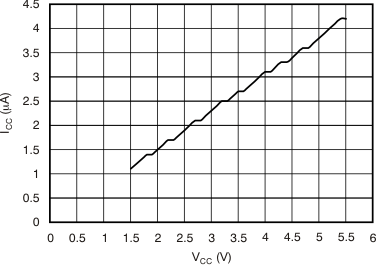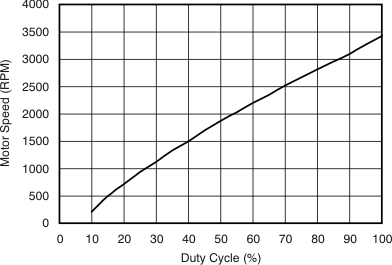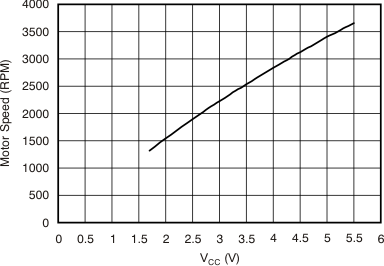SBVS206A November 2012 – March 2015 DRV10866
PRODUCTION DATA.
- 1 Features
- 2 Applications
- 3 Description
- 4 Revision History
- 5 Pin Configuration and Functions
- 6 Specifications
- 7 Detailed Description
- 8 Application and Implementation
- 9 Power Supply Recommendations
- 10Layout
- 11Device and Documentation Support
- 12Mechanical, Packaging, and Orderable Information
Package Options
Mechanical Data (Package|Pins)
- DSC|10
Thermal pad, mechanical data (Package|Pins)
- DSC|10
Orderable Information
6 Specifications
6.1 Absolute Maximum Ratings
Over operating free-air temperature range (unless otherwise noted).(2)| MIN | MAX | UNIT | ||
|---|---|---|---|---|
| Input voltage(1) | VCC | –0.3 | 6.0 | V |
| CS, FGS, PWM | –0.3 | 6.0 | V | |
| GND | –0.3 | 0.3 | V | |
| COM | –1.0 | 6.0 | V | |
| Output voltage(1) | U, V, W | –1.0 | 7.0 | V |
| FG | –0.3 | 6.0 | V | |
| Temperature | Operating junction temperature, TJ | –40 | 125 | °C |
| Storage temperature, Tstg | –55 | 150 | °C | |
(1) All voltage values are with respect to network ground terminal unless otherwise noted.
(2) Stresses beyond those listed under Absolute Maximum Ratings may cause permanent damage to the device. These are stress ratings only, which do not imply functional operation of the device at these or any other conditions beyond those indicated under Recommended Operating Conditions. Exposure to absolute-maximum-rated conditions for extended periods may affect device reliability.
6.2 ESD Ratings
| VALUE | UNIT | |||
|---|---|---|---|---|
| V(ESD) | Electrostatic discharge | Human body model (HBM), per ANSI/ESDA/JEDEC JS-001(1) | ±4000 | V |
| Charged-device model (CDM), per JEDEC specification JESD22-C101(2) | ±500 | |||
(1) JEDEC document JEP155 states that 500-V HBM allows safe manufacturing with a standard ESD control process.
(2) JEDEC document JEP157 states that 250-V CDM allows safe manufacturing with a standard ESD control process.
6.3 Recommended Operating Conditions
Over operating free-air temperature range (unless otherwise noted).| MIN | MAX | UNIT | ||
|---|---|---|---|---|
| Supply voltage | VCC | 1.65 | 5.5 | V |
| Voltage range | U, V, W | –0.7 | 6.5 | V |
| FG, CS, FGS, COM | –0.1 | 5.5 | V | |
| GND | –0.1 | 0.1 | V | |
| PWM | –0.1 | 5.5 | V | |
| Operating junction temperature, TJ | –40 | 125 | °C | |
6.4 Thermal Information
| THERMAL METRIC(1) | DRV10866 | UNIT | |
|---|---|---|---|
| DSC (WSON) | |||
| 10 PINS | |||
| RθJA | Junction-to-ambient thermal resistance | 42.3 | °C/W |
| RθJC(top) | Junction-to-case (top) thermal resistance | 44.5 | |
| RθJB | Junction-to-board thermal resistance | 17.1 | |
| ψJT | Junction-to-top characterization parameter | 0.3 | |
| ψJB | Junction-to-board characterization parameter | 17.3 | |
| RθJC(bot) | Junction-to-case (bottom) thermal resistance | 4.3 | |
(1) For more information about traditional and new thermal metrics, see the IC Package Thermal Metrics application report, SPRA953.
6.5 Electrical Characteristics
Over operating free-air temperature range (unless otherwise noted).| PARAMETER | TEST CONDITIONS | MIN | TYP | MAX | UNIT | ||||
|---|---|---|---|---|---|---|---|---|---|
| SUPPLY CURRENT | |||||||||
| IVcc | Supply current | TA = +25°C; PWM = VCC; VCC = 5 V | 2.5 | 3.5 | mA | ||||
| IVcc-Standby | Standby current | TA = +25°C; PWM = 0 V; VCC = 5 V | 5 | 10 | µA | ||||
| UVLO | |||||||||
| VUVLO-Th_r | UVLO threshold voltage, rising | Rise threshold, TA = +25°C | 1.80 | 1.9 | V | ||||
| VUVLO-Th_f | UVLO threshold voltage, falling | Fall threshold, TA = +25°C | 1.6 | 1.65 | V | ||||
| VUVLO-Th_hys | UVLO threshold voltage, hysteresis | TA = +25°C | 75 | 150 | 225 | mV | |||
| INTEGRATED MOSFET | |||||||||
| RDSON | Series resistance (H+L) | TA = +25°C; VCC = 5 V; IO = 0.5 A | 0.8 | 1.2 | Ω | ||||
| TA = +25°C; VCC = 4 V; IO = 0.5 A | 0.9 | 1.4 | |||||||
| TA = +25°C; VCC = 3 V; IO = 0.5 A | 1.1 | 1.7 | |||||||
| PWM | |||||||||
| VPWM-IH | High-level input voltage | VCC ≥ 4.5 V | 2.3 | V | |||||
| VPWM-IL | Low-level input voltage | VCC ≥ 4.5 V | 0.8 | V | |||||
| FPWM | PWM input frequency | 15 | 50 | kHz | |||||
| IPWM-Source | Standby mode, VCC = 5 V | 5 | µA | ||||||
| Active mode, VCC = 5 V | 100 | ||||||||
| TSTBY | PWM = 0 | 500 | µs | ||||||
| FG AND FGS | |||||||||
| IFG-Sink | FG pin sink current | VFG = 0.3 V | 5 | mA | |||||
| VFGS-Th | FG set threshold voltage | FG pin output, full FG signal, VCC ≥ 4.5 V | 0.8 | V | |||||
| FG pin output, one-half FG signal, VCC ≥ 4.5 V | 2.3 | ||||||||
| LOCK PROTECTION | |||||||||
| TLOCK-On | Lock detect time | FG = 0 | 2 | 3 | 4 | s | |||
| TLOCK-Off | Lock release time | 2.5 | 5 | 7.5 | s | ||||
| CURRENT LIMIT | |||||||||
| Current limit | CS pin to GND resistor = 3.9 kΩ | 680 | 800 | 920 | mA | ||||
| THERMAL SHUTDOWN | |||||||||
| TSHDN | Shutdown temperature threshold | 160 | °C | ||||||
| Hysteresis | 10 | ||||||||
6.6 Typical Characteristics
At TA = +25°C, with standard cooling fan, unless otherwise noted. Figure 1. Standby Current vs Input Voltage
Figure 1. Standby Current vs Input Voltage
 Figure 3. RPM vs Duty Cycle
Figure 3. RPM vs Duty Cycle
 Figure 2. RPM vs Input Voltage
Figure 2. RPM vs Input Voltage